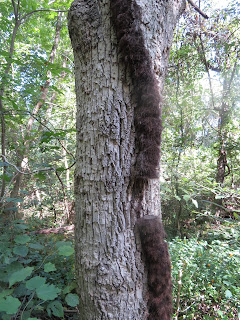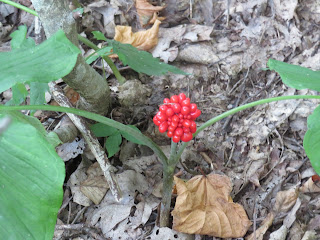A friend is closing out his section hike of the AT. This is one of his missing gaps. Beginning at the trailhead outside Front Royal on Rt 522, we pass by this chain link gate and fence for the first 1/4 mile. Obviously, it is a government facility. A sign says it is the National Zoological Park's breeding facility. That would explain the giraffe and panda.
While at the trailhead awaiting my friend, the kiosk had a notice from the local community to Trail Angels. It advises them to be mindful of the litter created by the packaged items being distributed. I wonder what happened. I would think Trail Angels would be careful to clean up.
Above are the seeds of Solomon's Plume. The mottled red color is quite nice.
Two big takeaways from today's hike, are the big trees, especially Tulip Poplars and all the Japanese Stiltgrass. The Stiltgrass probably covered the trailsides for 2 miles of this section. I've heard it theorized that the trail is a conduit for it to spread.
We walked through some overgrown fields to begin. Then up a long hill in mature hardwoods. The walk down the hill was very gradual and pleasant. Then we hit open fields where the trail was just a narrow dirt path. The temperatures started to rise. It would get well into the nineties, making afternoon unbearable.
Japanese Stiltgrass lines the trail
Poison Ivy with a missing link
Mosby, known as the Gray Ghost
The last mile was downhill but over rocky terrain. Just before reaching the trailhead, a poster espousing the virtues of opossums reminds us how beneficial these cuddly guys are.

























































